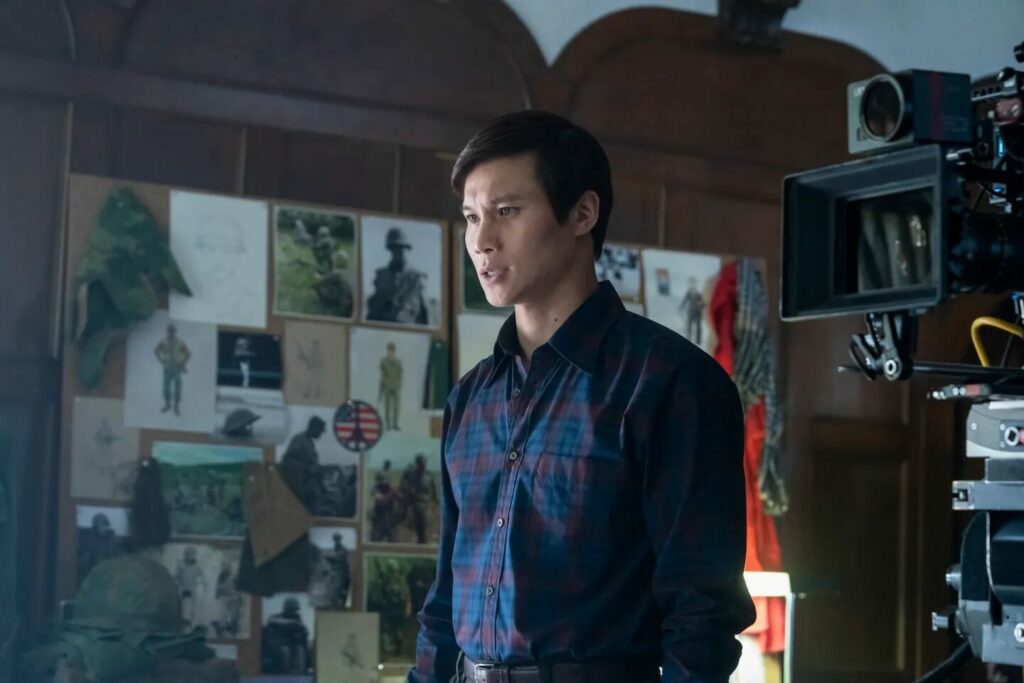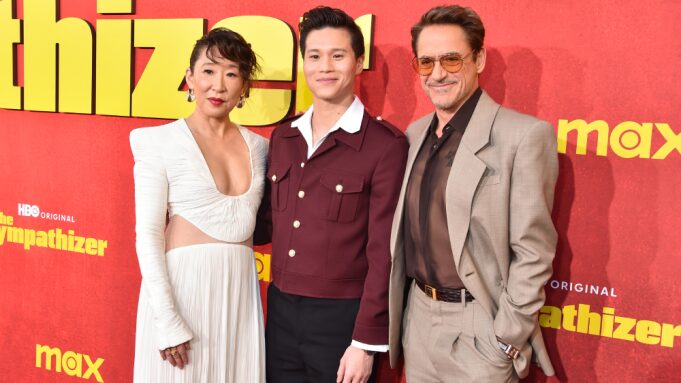HBO’s new miniseries centers Vietnamese voices — and reframes the consequences of war. Li Zhou writes for Vox

HBO/Warner Brothers
The Sympathizer, a new HBO series adapted from Viet Thanh Nguyen’s Pulitzer Prize-winning novel, demonstrates why perspective is so important when telling historical stories of conflict and warfare.
“All wars are fought twice,” an opening slide of the show reads. “The first time on the battlefield, the second time in memory.” That idea — penned by Nguyen — is central to both the novel and its adaptation, which highlight how US portrayals of the Vietnam War often omit the views of Vietnamese people, and undermine their humanity and agency by doing so.
Tellingly, the HBO series, which is helmed by famed South Korean director Park Chan-wook, is one of only a handful of mainstream US films or television shows that center Vietnamese or Vietnamese American perspectives while chronicling the war and its aftermath. By featuring these voices, the show reframes the consequences of the war, explores different Vietnamese stances on the conflict, and deepens viewers’ understanding of what the war’s refugees endured.
“So many books have been written about the Vietnam War, so many movies have been made about the Vietnam War, but from the point of view of the outsider,” Kieu Chinh, 86, an actor in the miniseries who herself fled Vietnam around the fall of Saigon, told Vanity Fair. “The Sympathizer was written by a refugee himself. I think it’s about time that a story like this should be told.”
The Sympathizer series comes as Hollywood continues to grapple with the fundamental question of perspective, and the way it changes how an event is depicted and perceived. As Jason Asenap wrote for Vox, Martin Scorsese’s Killers of the Flower Moon was scrutinized for recalling the killings of members of a Native American tribe from the vantage point of the white killer instead of a Native American person. Similarly, Christopher Nolan’s Oppenheimer was criticized for failing to include any Japanese viewpoints and solely conveying the consequences of the bombing from the American scientist’s view.
The Sympathizer confronts these issues directly in both its examination of perspective and how the show is presented. As the response from some Vietnamese American viewers indicates, it, too, offers just one of many positions people hold about the war. And though its ideas don’t always translate as well onscreen as they do in the novel, the series further underscores why the point of view a story is narrated from is critical.
How Hollywood has shaped Americans’ views of the Vietnam War
Hollywood has been wrestling with the Vietnam War ever since the US withdrew in the 197os.
Although many films condemned US involvement — a break from past war movies — they focused heavily on soldiers’ experiences and the trauma they dealt with in combat.
“Depictions of the war have tended to be pretty American-centric. So it’s been said that when Americans talk about the war, they’re really talking about themselves, you know, how they suffered, how they were divided as a nation,” says Duy Nguyen, a University of Houston world culture and literature professor who has specialized in Vietnamese studies.
As such, major films like Apocalypse Now and The Deer Hunter — though they eyed the war critically — were often deeply lopsided.
“The films about the war don’t really give Vietnamese people a voice at all. And that’s, I think, one of the tragedies,” says Phuong Nguyen, a historian at Cal State Monterey Bay who has written a book about Vietnamese refugee resettlement in the US.
Instead, as Viet Thanh Nguyen, the author of The Sympathizer, has written, Vietnamese characters were frequently reduced to props who were “killed, raped, wounded, silenced, demonized, or rescued while we serve as the backdrop for American moral dilemmas.”
In Casualties of War, a 1989 movie directed by Brian De Palma, for example, a Vietnamese girl is raped by American soldiers and “as a character is just rendered as pure, anonymous victimhood,” George Mason University historian Meredith Lair notes. “The Viet Cong are literally depicted as shadowy, faceless mole figures in a tunnel.”
Tropes about the Northern Vietnamese and Viet Cong soldiers frequently emphasized how vicious they were, removing any humanizing nuance. And American depictions of the Southern Vietnamese government suggested that they were incompetent and corrupt puppets of the US, depriving them of agency in their own decisions.
“Vietnamese communists are typically portrayed negatively in films as ruthless, ideological enemies posing a threat to American values,” says Alex-Thái Đình Võ, a historian at Texas Tech University. “In contrast, the Republic of Vietnam and its associates, America’s main allies during the war … are portrayed as either victims of war or, more often, as inept and corrupt allies, sometimes implicated in war crimes.”
The Sympathizer confronts these clichés with a subplot featuring the main character advising a clueless Hollywood director who is making a film about the Vietnam War. The auteur — played by Robert Downey Jr. and modeled after Francis Ford Coppola — initially attempts to deny speaking parts to any Vietnamese people before he’s convinced otherwise. (A running joke in the series looks at how many ways one Vietnamese extra, played by the main character’s friend, is able to die in the film.)
Given the ties between pop cultural portrayals and real-life prejudices, the one-sided depiction of Vietnamese people in Hollywood after a bitter war may have contributed to the hostile attitudes that many refugees encountered upon arriving in America, as well as enduring anti-Asian racism.
In a 1975 Gallup poll, more than half of Americans — 52 percent — opposed the resettlement of Vietnamese refugees in the US.
What The Sympathizer does
The Sympathizer reframes these narratives by centering a Vietnamese protagonist who offers insights into the perspectives of people in both North and South Vietnam, as well as a window into the refugee experience in America.
The lead character, referred to solely as Captain (Hoa Xuande), is a communist spy for the North working undercover in South Vietnam’s secret police. The show picks up shortly before the Fall of Saigon in 1975 and captures the chaos and terror as Southern Vietnamese people attempt to escape. It then follows the Captain as he and his close friends and colleagues navigate the refugee resettlement camps and related hardships in the US. The Captain continues his espionage on behalf of North Vietnam, though he begins to question his own allegiances as the narrative progresses.
By telling this story with these characters, The Sympathizer highlights the toll the war took on Vietnamese people and how diverse Vietnamese viewpoints were about the war. It also features Vietnamese characters as the principal actors in the conflict, rather than as supporting characters to Americans.
Documenting the chaos and horror of the Fall of Saigon from the vantage point of Vietnamese people trying to escape captures how traumatic that experience was, and what people lost when they fled. In one of the series’ most devastating scenes, Bon (Fred Nguyen Khan), one of the Captain’s best friends, mourns his wife and child when they are killed abruptly by an airstrike on the tarmac.
Subsequent episodes depict the dismal conditions that the characters have to deal with as they enter the US to live in refugee camps crawling with maggots, roaches, and rats.
Such perspectives help close the distance that has existed in portrayals of the war by making the stakes more accessible and intimate.
“They’re looking at regular people like Bon who just gave birth to a kid. And him and his wife are trying to figure out what his first words are,” says Phuong Nguyen. “These are people [who] have hopes and dreams, like every one of us.”
In chronicling refugees resettling in a new place and struggling to adapt, the show reminds the audience of how US actions have fueled waves of immigration from other countries. It captures, too, the casual racism that many refugees encountered including racial slurs, vandalism, and exoticization by the people around them.
“Americans like to imagine war stories featuring their heroic soldiers, sailors and pilots. The reality is that refugee stories are also war stories,” Viet Thanh Nguyen has written.
Because the story’s lead character is a spy and embodies a duality of political views, he also conveys how Vietnamese views on the war were far from monolithic and pushes back on how they’ve been generalized in the past. Supplementary characters, including two of the Captain’s friends, flesh these nuances out more.
“Shows tend to portray the war as one fought by the US against the communist North Vietnam and their southern allies, the Viet Cong,” says Van Nguyen-Marshall, a historian at Trent University. “However, the war was more complicated than that. It was first and foremost a civil war between Vietnamese themselves over the political configuration of their country. Vietnamese on both sides of the war fought and died in numbers that dwarf those of the US.”
Why this matters
By featuring Vietnamese characters as the arbiters of their narratives, The Sympathizer throws the horrors of war into even sharper relief.
“This is one of the things that makes The Sympathizer so powerful. The Vietnamese [people] speak for themselves in many different voices. They have different interests, different dreams, and different ways of dealing with the war and its legacies,” says Robert Brigham, a historian at Vassar College.
By providing these varying perspectives, the show forces a broader reevaluation of the conflict.
One of the biggest takeaways from Nguyen’s novel is how all parties are complicit in it. As well as holding the US accountable for its role, the novel does not shy away from critiquing the actions of both the Northern and Southern Vietnamese governments, and their role in perpetuating the harms of war against their own people. In showing the impact of war on people on different sides of it, including civilians, the series emphasizes its price.
“Vietnamese people have been represented as victims in dominant discourses, but this series will show us that we all participate in this monstrosity or the killings of others,” says Quynh Vo, a lecturer at American University who studies Vietnamese literature and culture.
Notably, the novel and series are also still only a slice of the many Vietnamese viewpoints that exist about the war. As the Los Angeles Times reported, some Vietnamese American viewers were troubled by what they initially perceived as the show’s favorable depiction of communism, which some of them had fought against. In both the novel and the show, male characters are also far more dominant than female ones, many of whom are underdeveloped, subject to violence, and given much less attention.
Still, The Sympathizer takes a powerful stand by expanding the scope of war stories.
“Centering Vietnamese characters and experiences in narratives about the Vietnam War is fundamental to shifting our understanding of the conflict,” says Đình Võ. “It allows for a deeper exploration of the human cost.”


